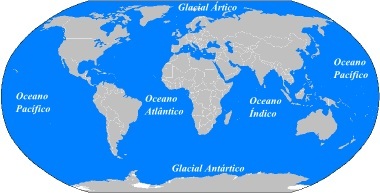The oceans comprise large spaces occupied by salt water, involving areas that are below the average altitude of the emerged lands, where the continents are. Together, they occupy 71% of the planet's surface and are home to a multitude of species of animals and plants, a large part still unknown to humans.
Human beings find it very difficult to visit the deepest places in the oceans. That's because the pressure of the water is so great that it would totally crush a person's body. Even the most modern equipment finds it difficult to reach this type of place. The deepest point ever visited reached a depth of 11 thousand meters, in the vicinity of the Marianas Trench, which is located 11,500 meters below the surface.
Take a look at the map below with the location of the planet Earth's oceans:

Map of all existing oceans
We can note that there are five oceans: Atlantic, Indian, Pacific, Arctic Glacier and Antarctic Glacier, although the last two are no longer considered as oceans, but as great seas. Find out below the main characteristics of each one of them.
Atlantic Ocean: its name was created from the Greek god called Atlas and is responsible for separating the Americas, Africa and Europe. It is about him that the main commercial exchanges in the world take place since the advance and growth of the capitalist system. It is the second largest ocean and its waters cover 20% of the Earth's surface.
Pacific Ocean: it gets its name because it was believed, in the past, that its waters were calmer, which is not entirely true. It is the largest of the oceans and covers almost a third of the planet's surface, containing many volcanoes within its waters. It separates Oceania, Asia and the west coast of the Americas. The Marianas Trench, the deepest point mentioned above, is in your area.
Indian Ocean: also called the “Sea of the Indies”, this ocean is smaller than the others, but it has great depths, some of which reach 9,000 meters below the surface. It bathes the east and southeast coasts of Africa and southern Asia, as well as the western part of Oceania.
Arctic Glacial Ocean: it is located to the north of the globe, in the region of the North Pole. Its waters bathe portions of the European continent, the Asian continent and parts of the American continent. It is considered the smallest and shallowest of the oceans. Part of its water remains frozen in the winter period.
Antarctic Glacial Ocean: It lies to the south, surrounding the continent of Antarctica and being fed by the southern Pacific, Indian and Atlantic oceans. At some points, it has temperatures that exceed minus 60 degrees.
By Rodolfo Alves Pena
Graduated in Geography
